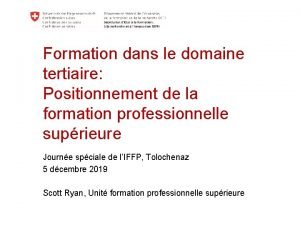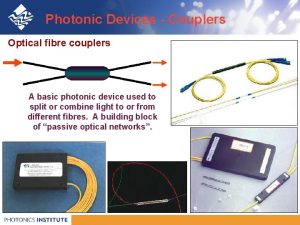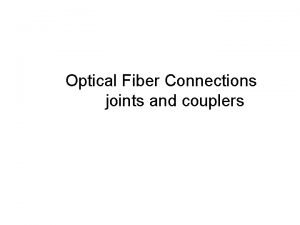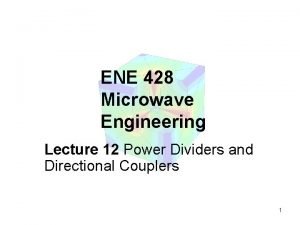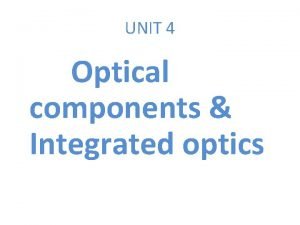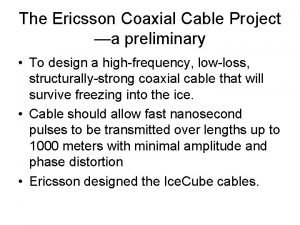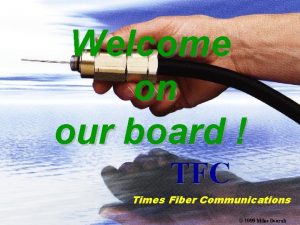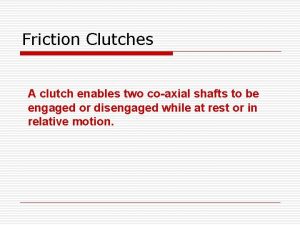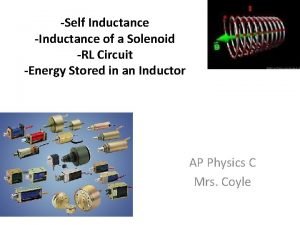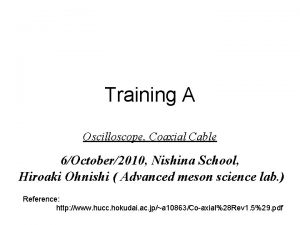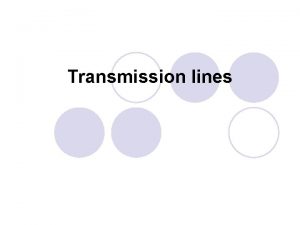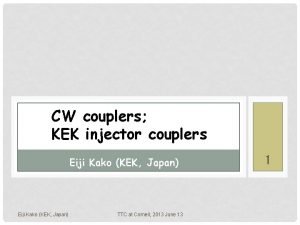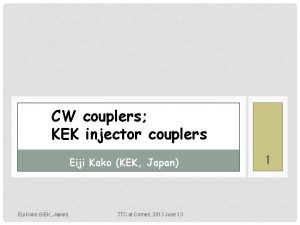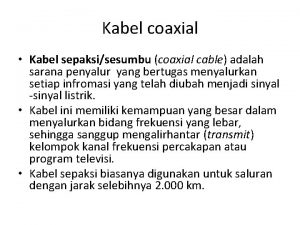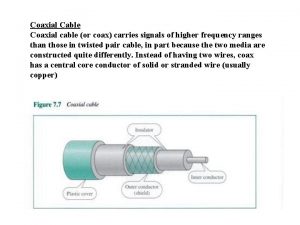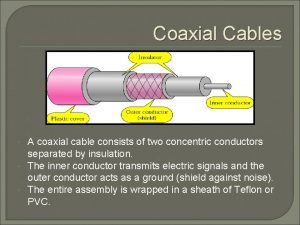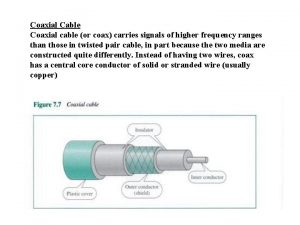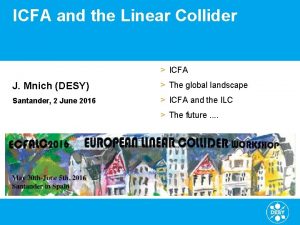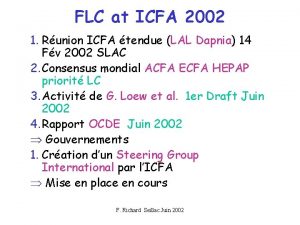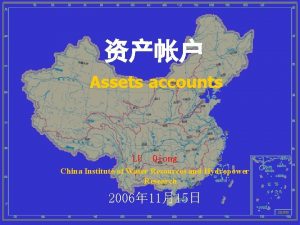Coaxial Couplers Qiong Wu The 59 th ICFA


















- Slides: 18

Coaxial Couplers Qiong Wu The 59 th ICFA Advanced Beam Dynamics Workshop Energy Recovery Linacs June 19 -23, 2017

Contents • Characteristics of Coaxial Couplers • Examples of couplers • Major issues in Coaxial Coupler design • Summary ERL 17, June 19 -23, Geneva 2

Characteristics of Coaxial Couplers Compared to the other type of RF power coupling method, waveguide, coaxial couplers have the advantages of : • Compact in size • Easy to modify design • Easy to add motion • Smaller heat leak However, the coaxial couplers are not ideal for: • High RF power handling, especially at high frequencies TTF 3 input coupler S. Bauer, ERL 04 • Sufficient cooling from easy design • Fast pump down ERL 17, June 19 -23, Geneva 3

Characteristics of Coaxial Couplers, cont’d • Coupling type • Electric – probe antenna • Magnetic – hook/loop antenna • Quality factor • Fixed external Q version – Tristan, b. ERLin. Pro, KEK, SNS, BNL • Variable external Q version – TTF 3, XFEL, ILC, LCLS-II • Operation • CW – high average power, needs longer time to condition, gas discharge needs shut down of RF to recover • Pulsed – lower average power, less discharge, transient conditions • Function • Fundamental mode power input (FPC) • Higher order mode damping • Pick-up signal for LLRF control ERL 17, June 19 -23, Geneva 4

Examples in Application – FPCs more than 10 yr old J. Delayen, USPAS, June 2008 S. Belomestnykh, SRF 13 CW Type: Frequency RF window Qext Max power Comments LEP 2 /SOLEI L 352 MHz Cylindrical 2 e 6/1 e 5 fixed Test: 565 k. W / 380 k. W Oper: 150 k. W Traveling wave @ Γ=0. 6 LHC 400 MHz Cylindrical 2 e 4 to 3. 5 e 5 Test: 500 k. W 300 k. W Traveling wave Standing wave HERA 500 MHz Cylindrical 1. 3 e 5 fixed Test: 300 k. W Oper: 65 k. W Traveling wave TRISTA N/KEKB /BEPCII 509 MHz Disk, coax 1 e 6/7 e 4/1. 7 e 5 fixed Test: 800 k. W Oper: 300 k. W 360 k. W Traveling wave APT 700 MHz Disk, coax 2 e 5 to 6 e 5 Test: 1 MW 850 k. W Traveling wave Standing wave Cornell ERL injector 1300 MHz Cylindrical 9 e 4 to 8 e 5 Test: 61 k. W Traveling wave ERL 17, June 19 -23, Geneva Forward power 5

Examples in Application – FPCs more than 10 yr old J. Delayen, USPAS, June 2008 S. Belomestnykh, SRF 13 Pulsed Type: Frequency RF window Qext Max power Comments SNS 805 MHz Disk, coax 7 e 5 fixed Test: 2 MW Oper: 550 k. W 1. 3 msec, 60 Hz J-PARC 972 MHz Disk, coax 5 e 5 fixed Test: 2. 2 MW 370 k. W 0. 6 msec, 25 Hz 3. 0 msec, 25 Hz FLASH (FNAL) 1300 MHz Conical (cold) WG planar (warm) 1 e 6 to 1 e 7 Test: 250 k. W Oper: 250 k. W 1. 3 msec, 10 Hz FLASH (TTF-II) 1300 MHz Conical (cold) WG planar (warm) 1 e 6 to 1 e 7 Test: 1 MW Oper: 250 k. W 1. 3 msec, 10 Hz FLASH/XFEL/ILC 1300 MHz (TTF-II) Cylindrical (cold and warm) 1 e 6 to 1 e 7 Test: 1. 5 MW 1 MW Oper: 250 k. W 1. 3 msec, 2 Hz 1. 3 msec, 10 Hz KEK STF Baseline ILC cavity 1300 MHz Disk, coax (cold and warm) 2 e 6 fixed Test: 1. 9 MW 1 MW 10 μsec, 5 Hz 1. 5 msec, 5 Hz KEK STF Low loss ILC cavity 1300 MHz Disk, coax (cold and warm) 2 e 6 fixed Test: 2 MW 1 MW 1. 5 msec, 3 Hz 1. 5 msec, 5 Hz ERL 17, June 19 -23, Geneva 6

Examples in Application – More recent FPCs Site Cavity Type Freq. Power Status BEPC-II IHEP Elliptical single cell (SC CW) 500 MHz Test: 420 k. W Operation: 150 k. W Beam Operation C-ADS IMP Spoke (SC CW) 325 MHz 162. 5 MHz Test: 10 k. W Operation: 10 k. W Beam commissioning LHC crab CERN DQW/RFD (SC CW) 400 MHz Operation: 100 k. W Construction MICE Cooling LBNL Pill-Box like (NC Pulsed) 201 MHz Peak: 2 MW Duty factor: 0. 1% Pulse length: 1 ms RF commissioned APEX Gun LBNL Single cell (NC CW) 186 MHz Operation: 87. 5 k. W Beam Operation APEX Buncher LBNL 2 -Cell (NC CW) 1300 MHz Operation: 7. 4 k. W Beam Operation FRIB MSU Half wave (SC CW) 322 MHz Test: 20 k. W 20% duty cycle Operation: 5 k. W Construction LCLS-II SLAC 9 -cell (SC CW) 1300 MHz Test: 4 k. W Operation: 4 k. W RF commissioning c. ERL Injector KEK 2 -cell (SC CW) 1300 MHz Test: 50 k. W Operation: 50 k. W Beam Operation ERL 17, June 19 -23, Geneva 7

Ref for previous slide • T. Huang, FPCs Development at IHEP, WWFPC Mini-workshop, CERN, 2016 • E. Montesinos, Last year experiences at CERN with FPC and future perspectives, WWFPC Mini-workshop, CERN, 2016 • H. Qian et. al. , DESIGN OF A 1. 3 GHZ TWO-CELL BUNCHER FOR APEX, IPAC 14 • F. Sannibale, APEX Phase-II Commissioning Results at the Lawrence Berkeley National Laboratory, IPAC 16 • T. Luo et. al. , PROGRESS ON THE MICE RF MODULE AT LBNL, IPAC 16 • Z. Zheng, Multipacting Free Coupler Design and Commissioning for FRIB, TTC 17 • N. Solyak, Coupler Performance at FNAL CM 02, PIPII Technical Meeting, 2017 • E. Kako et. al. , HIGH POWER TESTS OF CW INPUT COUPLERS FOR c. ERL INJECTOR CRYOMODULE, IPAC 12 • S. Sakanaka et. al. , Construction and Commissioning of Compact-ERL Injector at KEK, ERL 13 ERL 17, June 19 -23, Geneva 8

Examples in Application – Higher Order Mode Couplers 704 MHz booster cavity for LERe. C 56 MHz SRF cavity for RHIC Q. Wu et al. , SRF 15 TESLA type for LCLS-II Solyak et al. , SRF 15 • HOM damping with coaxial couplers usually have antennae with filters built together. • Type of coupling depends on the location of HOM coupler w. r. t. the cavity ERL 17, June 19 -23, Geneva 9

Major Issues Physical Mechanical Thermal • • • • RF transmission Unwanted RF modes Induce RF perturbation to beam Multipacting Discharge Sputtering Stress Connection Motion Installation tolerance Pumping Heat dissipation Cooling design Material selection Plating ERL 17, June 19 -23, Geneva Solutions: • Intensive simulation (CST, ACE 3 P, ANSYS, HFSS, etc. ) • Bellows • Coating (Ti. N) • Novel structure • Conditioning • Etc. 10

Major Issues – Matching J. Staples et al. , CBP tech note, 2013 Qian et al. , IPAC 14 • APEX Buncher Cavity. Transition structure from 20 Ohm to 50 Ohm. • No commercial feedthrough is available at the frequency and power level of APEX buncher cavity. Thus LBL design this low-Z coupler in house. ERL 17, June 19 -23, Geneva 11

Major Issues – Matching Ferrite absorber Ceramic window L d • LERe. C HOM damping added for existing 704 MHz half-cell cavity • Minimize the damping to TM 010 fundamental mode @ 704 MHz, d~λ 010/4, L~N/2*λ 010 • Maximize the damping to TM 020 1 st HOM @ 1. 489 GHz, d~λ 020/2, L~(N/2+1/4)λ 020 ERL 17, June 19 -23, Geneva 12

Major Issues – Multipacting • FRIB half-cell 322 MHz FPC • Multipacting caused by coaxial structure • Solution: Increase coupler impedance to increase RF power to avoid multipacting Z. Zheng et al. , TTC 17 Multipacting-free design saved 22 hours conditioning time compared to original design couplers ERL 17, June 19 -23, Geneva 13

Major Issues – Multipacting • • • MICE cooling cavity FPC Multipacting between cooling strip and cavity Solution: leaving cooling tubes only Courtesy of T. Luo, LBNL • • • BNL ERL Gun cavity Multipacting at coaxial structure Solution: RF conditioning W. Xu, WWFPC Mini-workshop 2016 ERL 17, June 19 -23, Geneva 14

Major Issues – Cooling Courtesy of W. Xu, BNL • ERL Gun cavity @ BNL • RF power input is 500 k. W per coupler • Water cooling for the inner conductor and air side, 5 K helium gas cooling at the vacuum side outer conductor. • LHC Double quarter wave crab cavity HOM coupler • 2 K helium cooling • ESS 352 MHz FPC • 2 water cooling sytems: • Window • Antenna (double enclosure) T. Capelli, Crab Cavity HOM Review 2015 ERL 17, June 19 -23, Geneva 15 E. Rampnoux, WWFPC Mini-workshop 2016

Major Issues – Cooling Another approach is to have cooling of the center conductor from physical connection to the outer conductor, which is easily cooled by ambient conditions… C-Shape Waveguide (CWG): deforming coaxial-waveguide coupler X. Chen, TTC 17 • Use TE 11 mode to transfer RF power down the coaxial structure. In TE 11 coaxial mode the horizontal plane is a perfect electric boundary condition. • Therefore, we can insert a metal plate without compromising the RF performance. Connecting inner and outer conductors Effective cooling of inner conductor through connecting plate. • This plate can be used to thermal anchor the temperature of the inner conductor. M. Sawamura, SRF 13 B. Xiao, SRF 15 ERL 17, June 19 -23, Geneva 16

Major Issues – Window T. Capelli, Crab Cavity HOM Review 2015 • APEX gun cavity • Crack window due to discharge • Elbow shape to shield RF window from dark current. • PS. This design also used Ti. N coating and permanent magnet to suppress multipacting Courtesy of T. Luo, LBNL • LHC crab cavity HOM coupler window • Special design for flexible mechanical connection and transmission of 1 k. W RF power at 400 MHz. Single window Easy design, easy cooling, Vulnerable cavity vacuum Double window Better protection to cavity, Hard design, hard cooling ERL 17, June 19 -23, Geneva 17

Summary • Coaxial couplers are widely used in both SC and NC RF resonators • Compared to waveguide coupling, coaxial couplers are compact and easy to modify, but not ideal for handling large RF power. • From various issues listed in this presentation, and much more details depends on each design, coaxial couplers are not easy to design. Sometimes the design is as complicated as the cavity, if not more. • Best solution for one cavity varies with the details of the entire cryomodule system and beam dynamics requirements. ERL 17, June 19 -23, Geneva 18
 Cfa restaurant du lac
Cfa restaurant du lac Icfa tertiaire
Icfa tertiaire Qiong luo
Qiong luo Qiong luo
Qiong luo Optical packet switching
Optical packet switching Velocity polygon analysis
Velocity polygon analysis A permanent joint formed
A permanent joint formed Power dividers and directional couplers
Power dividers and directional couplers Polka dot beam splitter
Polka dot beam splitter Hybrid fiber coaxial vs fiber optic
Hybrid fiber coaxial vs fiber optic Coaxial
Coaxial Teledrop
Teledrop Coaxial spring clutch
Coaxial spring clutch Cabo coaxial fino
Cabo coaxial fino Time constant for rl circuit
Time constant for rl circuit Inductance definition
Inductance definition Oscilloscope coaxial cable
Oscilloscope coaxial cable Soundblock coaxial speakers creative commons pictures
Soundblock coaxial speakers creative commons pictures The velocity factor of a transmission line depends on
The velocity factor of a transmission line depends on

